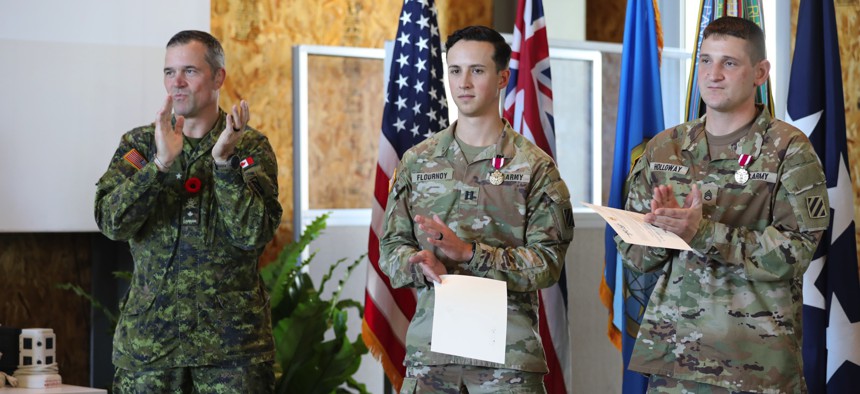
Brig. Gen. Pierre Huet, assistant commanding general for operations, XVIII Airborne Corps, congratulates winners of Dragons Lair IX, in Honolulu, Hawaii, on Nov. 2, 2023. U.S. Army / Spc. Casey Brumbach
Soldiers' winning idea hides friendly radio calls in a sea of noise
Innovation competition draws new devices and new methods to a showdown in Hawaii.
HONOLULU, Hawaii—A U.S. Army unit was preparing to go to the National Training Center last November when they discovered a problem: an adversary with electronic-warfare gear could “easily identify people talking on their radios…so they needed a way to counteract that.”
Lacking time to fix the problem, the unit handed it off to the Third Infantry Division’s Marne Innovation Team, said Capt. Chris Flournoy, one of the team’s innovation officers. Staff Sgt. Michael Holloway, an electronic warfare soldier, came up with a solution: a low-cost decoy emitter.
“Instead of trying to hide in the spectrum, we want to obfuscate the spectrum. We want to put so much emission into the spectrum” that an adversary “can’t tell what’s real and what’s fake,” Flournoy said.
The emitter, which Flournoy and Holloway hand-soldered in a maker space at Fort Stewart-Hunter Army Airfield, Georgia, recently took first prize in the Dragon’s Lair IX innovation competition here. The soldiers received a Meritorious Service Medal, will be able to attend a military school of their choosing, and earned the chance to implement their idea across the Defense Department.
The soldiers had already tested the emitter in the field at the Joint Readiness Training Center, Holloway said, which “opened up a lot of doors for working with other divisions within 18th Airborne Corps.”
The two runners-up in the competition offered separate improvements for moving injured troops. Chief Warrant Officer 2 William Ensinger and Staff Sgt. Jonathan Ensinger created a “practical replacement” for the Army’s rescue sled, and Chief Patrick McTavish thought of a way to standardize the way the Navy transports patients aboard ships.
The Navy currently moves patients from one level of a ship to another by wrapping a rope around a pipe “a couple of times,” and then attaching that rope to the stretcher “and kind of trying to pull the rope around the pipe,” McTavish said. His idea incorporates rock climbing equipment, “so instead of wrapping the rope around the pipe, now you wrap a sling around the pipe and you clip into the sling with a carabiner.”
McTavish’s method “basically speeds up the process” of setting up the system and moving the injured patient, and also gives corpsmen an advantage by reducing friction and the weight they have to pull on the line, he said.
“It’s a lot more efficient and it’s so much quicker,” McTavish said.
McTavish had been working on his idea for about a year and a half, and had trained other ships on the Pearl Harbor waterfront on it, but was thinking of scrapping it altogether before he heard of the Dragon’s Lair competition, he said. Now, he said, he has promises of funding and help to get it pushed throughout the Navy.
Doug Beck, director of the Pentagon’s Defense Innovation Unit, served as a judge for the competition. Beck said it’s “a tremendous way to recognize and develop innovators from within the force.”
Lt. Gen. Chris Donahue, commanding general of Fort Liberty and the 18th Airborne Corps, which co-hosted the competition, said it also allows the corps “to continue our focus to build readiness and retain our status as America’s Contingency Corps. We are incredibly proud of each of the eight innovator teams and look forward to continuing to inspire the talent within our formations.”




